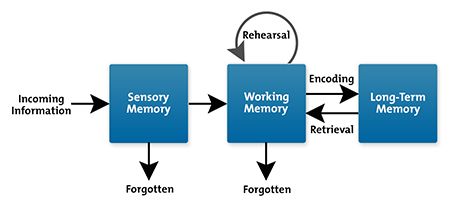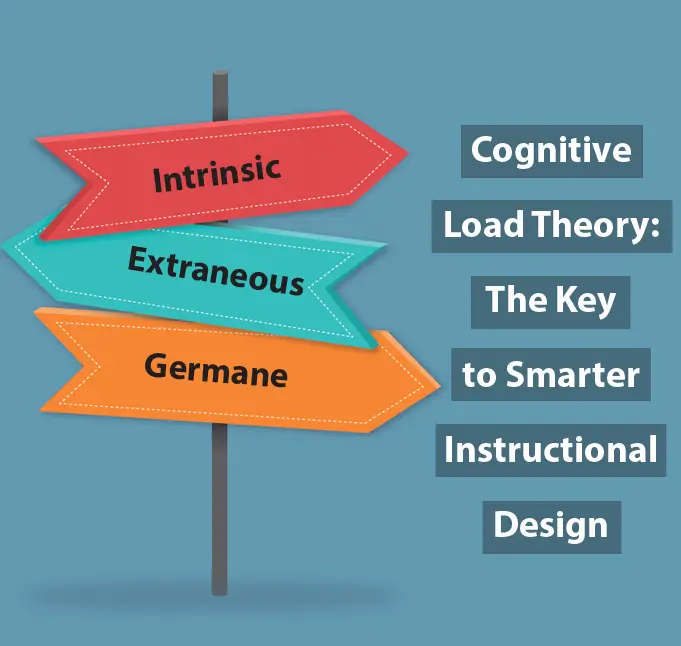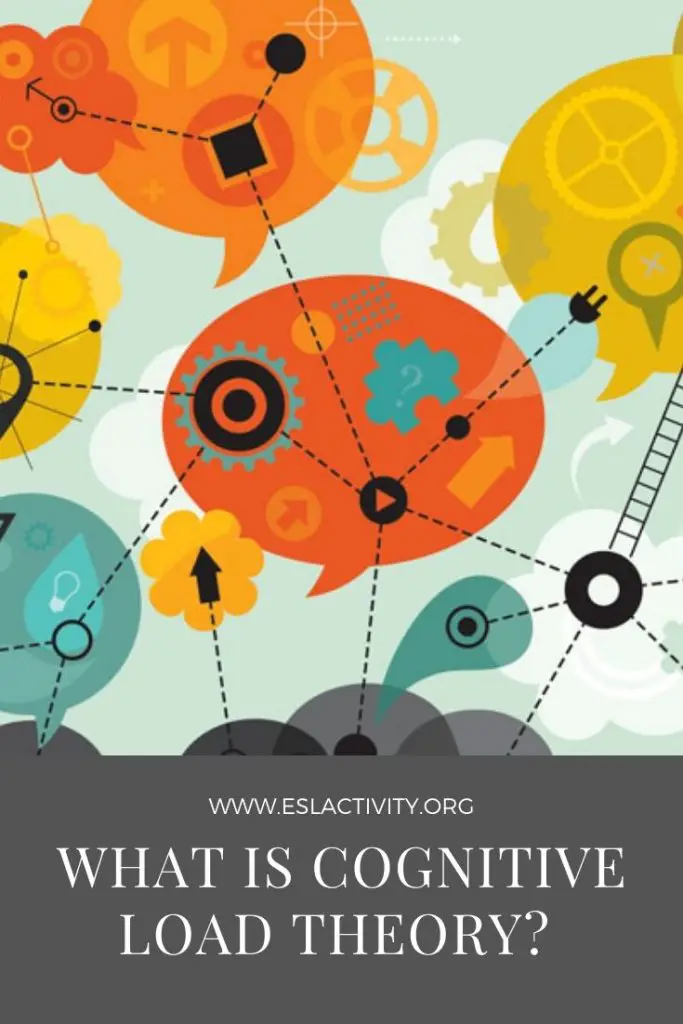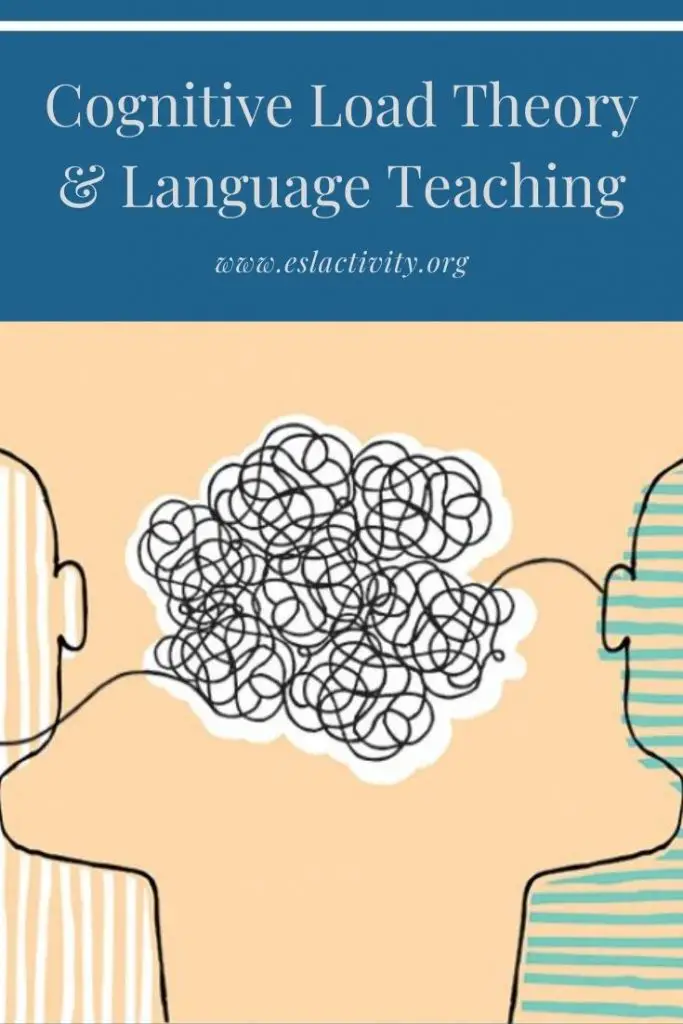I’m sure you’ve had the same experience as me! You’re sitting in a presentation or class and everything is going way over your head. There’s just too much material covered in too short of a time, or the material is too complex to even understand the basics of it. That’s where Cognitive Load Theory (CLT) by Sweller comes in.
Keep on reading to find out what Sweller cognitive load theory is, including intrinsic cognitive load, cognitive overload theory, and how to apply cognitive load theory in the classroom for both teaching and learning.
What is Cognitive Load Theory Based On?

Information Processing Model Atkinson & Shiffrin 1968
CLT is based upon an earlier, widely-accepted theory of human information processing from Richard Atkinson and Richard Shiffrin in 1968. They theorize that the processing of incoming information has three main parts:
- Sensory memory
- Working memory
- Long-term memory
The gist of it is that working memory has a limited capacity and also that only some of the information that is sensed makes it into the working memory while some of it is ignored. The working memory filters information and decides which to store in the long-term memory, or not.
The bottleneck in this model is the working memory which isn’t very large and can be easily overloaded. Research shows that we can only hold between 5 and 9 in there at any given time. From there, our brains categorize information into “schemas” which make it more memorable. Getting more practice with these schemas makes them effortless. This process is known as “automation.”
We’ll go into more detail about schemas and why they’re important for cognitive load theory. And, keep this background in mind for this newer theory of information processing and memory.
What is Sweller Cognitive Load Theory?

In 1988, John Sweller published a paper in Cognitive Science about Cognitive Load Theory. He changed the way we think about information processing and memory.
Working Memory = Limited
A “cognitive load” refers to how much information our working memory can hold at any one time. Because the working memory is quite limited, we should take care not to overload it with things that don’t directly contribute to learning. This is sometimes known as the cognitive overload theory.
How Auditory and Visual Information are Processed
One interesting aspect of this theory is that in the brain, auditory and visual information are processed separately. It’s known as the “modality effect.” This means that learning should combine auditory and visual information in tandem. For example, explaining a complex diagram by talking about it can be easier to understand than adding more details to it.
Automation in Long-Term Memory
Another key aspect to consider is the way working memory handles automation and schema in our long-term memory. Working memory handles well-established schema as a single item and automated schema hardly counts towards the finite number of items. This means that drawing upon existing knowledge is key to learning and also that pre-teaching basic things will help learners remember more complex and difficult information.
John Sweller’s Three Types of Cognitive Loads
In his theory, John Sweller mentions three different types of cognitive loads. These are broad categories.
Intrinsic Cognitive Load
Some things are more complicated and difficult than others. Advanced algebra is more difficult than simple multiplication. In language learning, the simple past is easier than the various conditional forms. This refers to the intrinsic load of the task.
Extraneous Cognitive Load
In poorly designed classrooms, courses, or other learning situations, there is often a lot of information given that is not really that important. It can distract from the key information that should be grasped. This is known as extraneous cognitive load and as much of this should be avoided as possible.
Germane Cognitive Load
This refers to how learners link their current knowledge with additional information. It’s vital that teachers assist with this process by setting the context and drawing on students’ prior knowledge whenever possible.

What is Cognitive Load Theory?
How Can I Apply Cognitive Load Theory in the Classroom?
Using these principles well can help make training more effective. Here are a few of the key elements to keep in mind.
Measure and Adapt to Expertise
Keep in mind that schema counts as a single item in working memory. That’s why it can be helpful to find out how much learners already know about a certain topic and adapt training for this prior expertise.
After all, a lesson on the future forms in English will look quite different for a learner seeing it for the first time and for advanced learners who are learning the subtle differences between them and when to use each one. Always adapt training accordingly.
Reduce Problem Space
Problem space refers to the gap between the current situation and the desired goal. As a teacher, it should be our goal to ensure that this gap isn’t too large such that new information will help learners get to where they need to be.
For complex problems, this may require breaking it down into parts in a way that doesn’t require learners to hold too much information in their working memories. Another way to handle this is to provide examples with partial solutions and allow learners to work through the last bit.
Reduce Split-Attention Effect
Try to reduce learner attention as much as possible to the most important things. Too much going on can distract attention. For example, place the label directly on the object in a diagram instead of in a box to the side. Avoid “keys” as much as possible for this kind of thing.
Aim to reduce things happening outside your classroom. Close the door or window if it’s very noisy. Ask that students put away their cell phones.
Consider Auditory and Visual Channels in Working Memory
Auditory and visual channels each have their own working memory and they don’t compete with each other for the limited space. A simple way to do this is to show a diagram and then talk about it, as opposed to writing all the information in a box next to the picture.
Want to learn more about teaching language? Check out: Teaching language methods.
Tips for Reducing Cognitive Load in the Classroom
Richard Meyer wrote a paper in 2020 that listed some tips for how to reduce cognitive load in the classroom. Here’s a brief overview of things to keep in mind when planning a lesson. Apply your knowledge of cognitive load theory in the classroom.
Coherence Principle
KISS! Keep it simple, stupid. Remember to reduce the amount of information only to what is necessary. Focus on giving simple instructions and only the ones that really matter.
Signaling Principle
Be sure to highlight what is most important. There are various ways to do this but use a diagram, gesture with your hand to something on the board, or explicitly tell students to pay close attention to what you will say next. Voice inflection and pauses when speaking can help with this as well.
Redundancy Principle
Avoid doing things like reading information from a screen. This isn’t helpful. And don’t keep repeating instructions in the same exact way if students don’t understand. Perhaps do a demo instead.
Spatial Contiguity
Place related things close together in diagrams. This helps organize them in schema more easily. For example, have a picture of a new vocabulary word and the label on the same slide, right next to each other.
Temporal Contiguity
This refers to talking about similar things within a small time frame. In conversation, it’d be odd to jump back to a topic from 20 minutes ago when the conversation has moved on. It’s the same in a lesson!
But, Not Too Simple!
Don’t go overboard with this though. Presenting something complicated in a way that oversimplifies it can lead to ambiguity and leave out important details.
Language lessons where the teacher uses “baby talk” and omits articles for example aren’t that helpful and don’t provide a great model for students.
There is certainly a middle ground. Try as much as possible to reduce the cognitive load for learners but don’t oversimplify things too much.

Cognitive Load Theory and Language Teaching
Sweller Cognitive Load Theory Implications for Language Teaching and Learning
There are a number of implications for language teaching and CBL. Here are a few of the main things to keep in mind.
Set the Context
It’s important to set the context in any lesson plan to help students activate their prior knowledge. This is closely related to schema and automation. Some simple ways to do this are to use a warm-up activity or something like Word Association, or the A to Z game.
Key Concepts Only to Reduce Intrinsic Load
Sure, it can be tempting to cover every single thing in a language lesson! However, it’s not helpful.
The way that I handle this in a grammar or vocabulary lesson is to first set the context. Then, I have students discover the language in a reading or listening passage. After that, I’ll do some explicit teaching, but only the basics. After that, it’s time for some practice and only after that is done will I talk about the exceptions.
I personally would rather my students have a solid grasp on a few key things instead of knowing everything just a little.
Review, Review, Review
The goal of a teacher should be for a new language to become schema and ultimately automatic. This happens through lots of reviews, both in class and at home for the students. Here are some of my recommendations: ESL Review Activities.
Also, be sure to make liberal use of concept checking by way of simple questions that are used to check the form, meaning, or function of the target language.
Giving Instructions and Intrinsic Cognitive Load
Keep it simple, stupid! What are the fewest instructions you can give to result in students doing the activity that you want them to do? That’s what we should aim for.
And, don’t forget about ICGs (instruction checking questions) to make sure students actually understand.
Think about Teacher Talk
Aim for the middle ground. Baby talk is ridiculous for an adult so keep those articles in there and speak in grammatically correct sentences.
However, grade language by speaking more slowly and using simple vocabulary or grammatical structures. And of course, omit fluff words that don’t aid in understanding. Check out these two examples:
- Okay, so anyway, you’re going to find a partner first. Then, just talk them about their experience this weekend. What they did, where they went, how it was in general. Oh, the past tense. You’ll want to use the past tense okay? Alrighty. Go get your partner. You got one? Talk for 5 minutes now and I’ll stop you when it’s done. Okay. Get started. Why isn’t anyone talking?
- Find a partner. Talk with them for 5 minutes about this past weekend. Don’t forget to use the past tense.
Which one is better? Obviously the second! I’ve honestly heard something similar to the first one far too many times! Avoid this at all costs.
Find out the Students’ Level First, Whenever Possible
Take advantage of your expertise! If at all possible, find out the level of the students before teaching them. If you can’t, you’ll know soon enough within a lesson or two, and then get ready to adapt. The goal should be to present information that has a small gap between what students already know and what they don’t.

Cognitive Load Theory: Implications for Teaching Languages
Who is John Sweller?
John sweller is an Australian educational psychologist. He’s best known for his cognitive load theory which was quite influential in the world of education. He is currently a professor emeritus at the University of New South Wales (2020). He has published more than 80 works, mostly related to the limitations of working memory and the consequences that has for giving instructions.
FAQs About Cognitive Load Theory
Here is a quick guide to some commonly asked questions about Sweller cognitive load theory in the classroom.
What is cognitive load theory of learning?
Cognitive load theory (CLT) is an instructional theory by John Sweller that reflects the way people process information. Newly obtained information must be in the working memory until it has been processed enough to move to our long-term memory.
What are the three types of cognitive load?
According to John Sweller, the three types of cognitive load are intrinsic load, germane load, and extraneous load.
How useful is cognitive theory for teachers?
Sweller’s cognitive load theory helps ESL teachers understand how students process new information. Teachers can reflect on their classroom environment and ways of teaching. The subtle changes made based on the cognitive load theory can improve ESL students’ learning. For example, teachers can reduce the problem space and split-attention effect.
More Ideas for Taking Cognitive Load Theory Into Account in a Language Classroom
Cognitive Load Theory (CLT) provides insights into how the human mind processes information and how the cognitive load imposed on learners can affect their learning outcomes. Language teachers can apply CLT principles in the classroom to optimize instructional design and enhance students’ language acquisition. Here are some strategies that language teachers can use to incorporate CLT in their teaching:
Manage working memory load
Working memory has limited capacity, so teachers should avoid overwhelming students with too much new information at once. Chunking the content into smaller, manageable units and providing clear instructions can help reduce cognitive load. For example, when introducing new vocabulary, teachers can present it in groups or categories instead of individual words.
Activate prior knowledge
Prior knowledge serves as a foundation for learning new information. Before introducing a new language concept or skill, teachers can activate students’ prior knowledge by asking questions, conducting brief discussions, or providing a short review of related topics. This helps in reducing cognitive load by connecting new information to existing mental frameworks.
Provide scaffolding
Scaffolding refers to providing support and guidance to learners as they develop their language skills. Teachers can offer step-by-step instructions, models, and examples to guide students through complex tasks. Breaking down complex tasks into smaller, manageable steps reduces cognitive load and helps students build their skills gradually.
Use visual aids
Visual aids, such as diagrams, charts, and illustrations, can help reduce cognitive load by presenting information in a more accessible and memorable format. Teachers can use visual representations to illustrate grammar rules, vocabulary relationships, or language structures, making the learning process more engaging and less demanding on working memory.
Incorporate multimedia and technology
Carefully selected multimedia resources, such as videos, audio recordings, or interactive online exercises, can enhance learning by presenting information in diverse formats. However, it’s crucial to ensure that the multimedia elements are relevant, well-structured, and not overly complex, as they should support learning rather than overload cognitive resources.
Provide opportunities for practice and feedback
Practice and feedback are vital for language acquisition. Teachers should create opportunities for students to apply their knowledge and skills in meaningful contexts. This can include communicative activities, role-plays, discussions, or writing tasks. Constructive feedback helps students identify areas of improvement and adjust their learning strategies accordingly, reducing cognitive load by fostering metacognitive awareness.
Consider the expertise level of learners
Cognitive Load Theory suggests that the level of expertise of learners affects the cognitive load imposed by instructional materials. Teachers should carefully assess students’ proficiency and adjust the complexity and difficulty level of tasks accordingly. For example, beginners may need more explicit guidance and simplified tasks, while advanced learners can handle more complex challenges.
Have your Say about Sweller Cognitive Load Theory
Do you have any tips or tricks for how to take CLT into account when teaching or learning? Leave a comment below and let us know your thoughts. We’d love to hear from your
Also, be sure to give this article a share on Facebook, Pinterest, or Twitter. It’ll help other busy teachers, like yourself find this useful resource.




